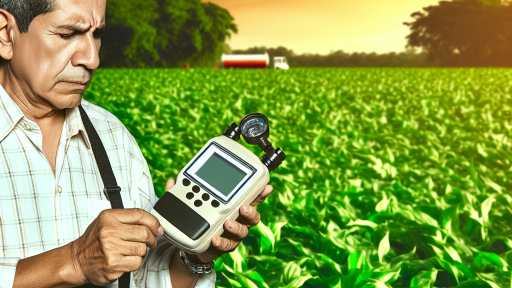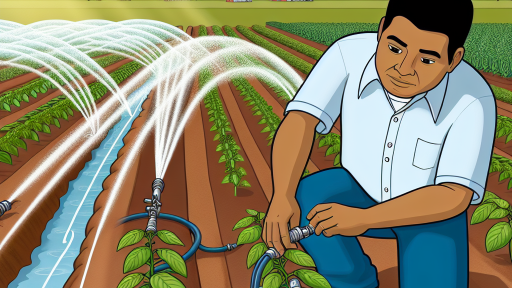Overview of Climate Change and Its Global Impact on Agriculture
Climate change poses significant challenges to global agriculture.
This phenomenon leads to altered weather patterns and intensifies natural disasters.
Farmers worldwide must adapt to increased temperatures and unpredictable rainfall.
Changing Weather Patterns
Weather changes affect the timing of planting and harvesting crops.
For instance, some regions experience prolonged droughts.
In contrast, others face excessive rainfall and flooding.
These fluctuations can disrupt supply chains and reduce crop yields.
Impact on Crop Production
Climate change affects various aspects of crop production.
Higher temperatures can reduce yields of staple crops like wheat and rice.
Moreover, changes in precipitation patterns hinder soil moisture retention.
This can lead to lower nutrient levels and poor soil health.
Effects on Livestock
Livestock producers also face challenges due to climate change.
Heat stress affects animal health and productivity significantly.
Additionally, changing forage quality impacts feed availability.
As a result, livestock farmers must adapt their practices to maintain productivity.
Transform Your Agribusiness
Unlock your farm's potential with expert advice tailored to your needs. Get actionable steps that drive real results.
Get StartedEconomic Consequences
The financial viability of farms depends on climate stability.
As adverse weather events increase, so do production costs.
Consequently, farmers may experience reduced profits and increased debt.
This situation can lead to a cycle of economic decline in rural areas.
Global Initiatives and Adaptation Strategies
In response to these challenges, global initiatives are emerging.
Agencies promote sustainable farming practices to combat climate impact.
Farmers are encouraged to adopt technology and improve resource management.
Additionally, crop diversification helps mitigate risks associated with climate variability.
How Temperature Fluctuations Affect Crop Yields and Quality
Impact of Temperature on Crop Growth
Temperature significantly influences crop growth stages.
Extreme temperatures can disrupt key developmental phases.
For instance, high temperatures can accelerate flowering but reduce seed quality.
Conversely, cooler temperatures can delay growth and extend the growing season.
Effects on Quality of Produce
Temperature fluctuations affect the quality of harvested crops.
High temperatures often lead to increased sugar content in fruits.
This can enhance flavor, but can also result in reduced size and marketability.
Additionally, temperature stress can make crops more prone to diseases.
Impact on Yield Variability
Yield variability increases with rising temperature extremes.
Farmers face unpredictable crop outputs every season.
Consequently, crop insurance and financial planning become more critical.
Understanding these risks helps farmers make better decisions.
Adaptive Strategies for Climate Change
Farmers can adopt various strategies to mitigate temperature impacts.
Utilizing shade structures can protect crops from excessive heat.
Planting heat-resistant varieties offers another viable solution.
Moreover, implementing drip irrigation can reduce water stress.
Showcase Your Farming Business
Publish your professional farming services profile on our blog for a one-time fee of $200 and reach a dedicated audience of farmers and agribusiness owners.
Publish Your ProfileLong-Term Economic Implications
Temperature fluctuations lead to rising production costs.
These increased costs can diminish farm profitability over time.
Farmers must adapt to stay competitive in a changing climate.
Investments in technology may offer long-term solutions to these challenges.
The Impact of Altered Precipitation Patterns on Water Availability for Farming
Understanding Precipitation Changes
Climate change significantly alters precipitation patterns across the globe.
Farmers face unpredictable rainfall, which complicates planning.
Some regions experience drought, while others endure heavy flooding.
This variability directly impacts water availability for crops.
Implications for Water Resources
Water scarcity emerges as a pressing concern in agriculture.
Farmers rely on consistent rainfall to sustain crop growth.
Moreover, reduced snowpack limits water access in springtime.
Consequently, farmers may struggle to irrigate their fields adequately.
Impact on Crop Yields
Altered precipitation patterns can devastate crop yields.
Drought conditions stress plants, leading to lower productivity.
On the other hand, excess rainfall increases the risk of disease.
Farmers must adapt their practices to mitigate these challenges.
Economic Consequences
Reduced crop yields directly affect farm profitability.
Lower productivity leads to decreased revenue for farmers.
Additionally, increased costs for irrigation systems strain budgets.
Farmers must invest in resilience strategies to cope with uncertainty.
Adaptation Strategies
Farmers adopt various strategies to manage changing precipitation.
One effective approach involves diversifying crop selections.
Cover crops help retain soil moisture and enhance resilience.
Furthermore, efficient irrigation practices can optimize water usage.
Explore Further: Benefits of Agroforestry for Carbon Sequestration
Effects of Extreme Weather Events on Farm Operations and Infrastructure
Introduction to Extreme Weather Challenges
Extreme weather events increasingly disrupt traditional farming practices.
These events include floods, droughts, and hurricanes.
Farmers face significant challenges as weather patterns shift.
Impact on Crop Production
Extreme weather directly affects crop yields.
For example, flooding can drown seedlings, while droughts can lead to crop failure.
Moreover, unpredictable weather makes planning difficult for farmers.
As a result, farmers may need to adjust planting schedules.
Infrastructure Damage
Extreme weather causes substantial damage to farming infrastructure.
Heavy rains can wash away soil and damage storage facilities.
High winds can destroy barns and equipment sheds.
Consequently, farmers often bear high repair costs.
This adds financial strain and reduces profitability.
Financial Implications
The financial impact of extreme weather is profound.
Insurance claims may lead to delays in recovery.
Additionally, the cost of seeds and replanting is significant after losses.
Showcase Your Farming Business
Publish your professional farming services profile on our blog for a one-time fee of $200 and reach a dedicated audience of farmers and agribusiness owners.
Publish Your ProfileFarmers may struggle to secure loans due to previous weather-related losses.
Adaptation Strategies
Farmers are adopting various strategies to cope with extreme weather.
Implementing improved irrigation systems can mitigate drought impacts.
Additionally, diversifying crops can reduce risk from specific weather events.
Investing in weather-resistant infrastructure can also provide long-term benefits.
Moreover, farmers are increasingly utilizing technology for better forecasting.
Resilience Building in Farming
Building resilience against extreme weather is crucial for farmers.
Farmers who adapt can protect both their operations and profitability.
Consequently, community support and government initiatives play a key role.
Such efforts can enhance agriculture’s long-term viability amidst climate change.
Discover More: Boosting Farm Income Through Climate Adaptation
Economic Implications of Pest and Disease Outbreaks Due to Changing Climates
Overview of Climate Change Impacts
Climate change significantly alters pests and diseases in agriculture.
Warmer temperatures enable pests to thrive in new areas.
Biodiversity loss due to climate change increases pest vulnerability.
Direct Economic Consequences
Pest outbreaks can drastically reduce crop yields.
Farmers face increased costs for pest management strategies.
Higher pesticide use can lead to environmental concerns.
Additionally, poor crop quality due to infestation can diminish market prices.
Long-Term Implications for Farm Profitability
Consistent crop failures can jeopardize farm sustainability.
Increased variability in harvest can disrupt cash flow.
Farmers may need to seek additional funding to cover losses.
Long-term reliance on chemicals can harm soil health and fertility.
Adaptation Strategies for Farmers
Farmers should adopt integrated pest management techniques.
Embracing organic farming practices can lessen pest impact.
Investing in climate-resilient crop varieties proves beneficial.
Building healthy soil through sustainable practices enhances resilience.
Future Economic Considerations
Ongoing climate variability necessitates constant adaptation by farmers.
Market dynamics will shift based on pest and disease prevalence.
Ultimately, proactive measures will determine long-term farm viability.
Explore Further: Water-Saving Tips for Small-Scale Farmers

The Role of Sustainable Practices in Mitigating Climate Risks for Farmers
Importance of Sustainable Practices
Sustainable practices enhance resilience against climate-related disruptions.
They help farmers adapt to changing weather patterns effectively.
Moreover, these practices contribute to better soil health and productivity.
Soil Management Techniques
Employing cover crops can significantly improve soil quality.
These crops prevent erosion and promote biodiversity.
Additionally, crop rotation enhances nutrient availability in the soil.
Both methods bolster crop yields over the long term.
Water Conservation Strategies
Water conservation is crucial in regions prone to drought.
Farmers can adopt drip irrigation systems to optimize water use.
This approach reduces waste while maintaining crop health.
Showcase Your Farming Business
Publish your professional farming services profile on our blog for a one-time fee of $200 and reach a dedicated audience of farmers and agribusiness owners.
Publish Your ProfileUtilizing rainwater harvesting further supports sustainable farming.
Integrated Pest Management
Integrated Pest Management (IPM) minimizes chemical pesticide reliance.
This strategy promotes natural pest control methods, enhancing ecosystem balance.
Furthermore, IPM can reduce costs associated with pest outbreaks.
As a result, it contributes to higher profit margins for farmers.
Benefits of Organic Farming
Organic farming practices align with sustainability goals.
They focus on natural inputs, reducing chemical runoff into water systems.
Organic farms often experience higher prices for their products.
This price premium can significantly increase profitability.
Community Engagement and Education
Engaging local communities creates awareness about sustainable agriculture.
Farmers benefit from shared resources and knowledge exchange.
Workshops and training can empower farmers with new techniques.
This collaboration fosters a stronger agricultural community.
You Might Also Like: Renewable Energy Strategies for Climate-Resilient Farms
Case Studies of Farms Adapting to Climate Change Challenges
Innovative Irrigation Techniques
Farmers are implementing advanced irrigation systems to conserve water.
These systems reduce water waste during drought conditions.
Agricultural engineer Sarah Thompson developed a drip irrigation method.
This technique decreases water usage by targeting plant roots directly.
As a result, farmers like Mark Robinson increased crop yields significantly.
Diverse Crop Rotation Practices
Diverse crop rotation enhances soil fertility and resilience.
Farmers are now planting different crops each season for better results.
Jane Lee, a local farmer, switched from monoculture to polyculture.
This approach improved her farm’s resistance to pests and diseases.
Consequently, her profitability expanded by 20% over two years.
Utilizing Climate-Resistant Varieties
Climate-resilient crop varieties are increasingly popular among farmers.
These crops withstand extreme weather events better than traditional options.
Tom Garcia’s farm adopted drought-resistant corn and soybeans.
His harvests remain stable despite erratic rainfall patterns.
This choice has proven economically favorable for his farming operation.
Community Support and Collaboration
Farmers are forming cooperatives for shared resources and knowledge.
This collaboration empowers them to tackle climate challenges collectively.
The Green Valley Farmers Collective supports sustainable practices.
Members share tools, labor, and techniques, enhancing productivity.
Such initiatives have improved overall farm profitability for participants.
Investing in Technology
Technology adoption is transforming sustainable farming practices.
Farmers are using drones for precision agriculture and monitoring.
These devices help in identifying crop health and irrigation needs.
Daniel Yates integrated drones into his farm management strategy.
Consequently, his input costs decreased while yields improved markedly.
Future Projections for Farm Profitability in the Context of Ongoing Climate Change
Increasing Weather Variability
Farm profitability increasingly hinges on unpredictable weather patterns.
Showcase Your Farming Business
Publish your professional farming services profile on our blog for a one-time fee of $200 and reach a dedicated audience of farmers and agribusiness owners.
Publish Your ProfileFarmers must adapt to more frequent droughts and floods.
This unpredictability poses significant risks to crop yields.
Therefore, understanding regional climate impacts is essential.
Shifting Crop Viability
Crops suitable for certain regions may change as temperatures rise.
Farmers need to explore alternative crops that thrive in altered climates.
In many instances, transitioning to new crops involves steep learning curves.
Consequently, proper research and planning are vital before making changes.
Increased Pest and Disease Pressure
Climate change can intensify pest populations and disease outbreaks.
Farmers might spend more on pest management and crop protection strategies.
This situation could lead to diminished profit margins over time.
Consequently, investing in integrated pest management becomes crucial.
Changing Market Demand
Consumer preferences shift in response to climate change effects.
For example, more buyers may seek organic and sustainable options.
Farmers should adapt their practices to align with market trends.
Those who recognize and respond quickly can gain a competitive edge.
Access to Resources and Support
Farmers may benefit from increased government and NGO support.
Programs focusing on resilience-building are likely to expand.
Moreover, farmers should stay informed about available resources.
Access to funding can help farmers invest in necessary adaptations.
Long-term Sustainability Practices
Implementing sustainable farming practices can mitigate risks.
Rotational grazing and cover cropping improve soil health.
These practices enhance farm resilience against climate impacts.
Total farm profitability often rises when sustainability is prioritized.
Technological Innovations
Farm profitability may also be influenced by technology advancements.
Precision agriculture aids in efficient resource usage and monitoring.
Farmers can minimize waste and enhance productivity through technology.
Investing in modern tools can lead to significant cost savings.
Additional Resources
Agriculture in a Changing Climate | USDA Climate Hubs
Climate Change and U.S. Agriculture: An Assessment of Effects and …




